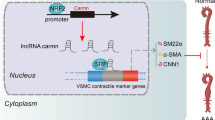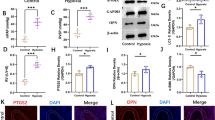Abstract
Purpose
Long non-coding RNAs (lncRNAs) have been reported to play significant roles in the pathogenesis of diabetic retinopathy (DR). The aim of the present study was to investigate the role of lncRNA Arid2-IR in advanced glycation end product (AGE)-induced human retinal endothelial cells (HRECs) injury.
Materials and methods
Cell viability was determined by Cell Counting Kit-8 assay following induction with AGEs. The expression of Arid2-IR and Smad3 was detected by reverse transcription-quantitative PCR or western blotting. A luciferase reporter assay was conducted to determine the interaction between Arid2-IR and Smad3. The levels of inflammation-related and oxidative stress-related factors were evaluated by respective kits. The expression of extracellular matrix (ECM)-related and apoptosis-related proteins was detected by western blotting. Immunofluorescence assay was used to detect the level of vascular endothelial growth factor, and flow cytometry was applied to measure the levels of apoptosis.
Results
The results revealed that AGE treatment decreased HREC proliferation and upregulated the expression of Arid2-IR and Smad3. The luciferase assay indicated that Smad3 was able to bind to the promoter region sequence of Arid2-IR. Moreover, Arid2-IR silencing reduced inflammation, oxidative stress and ECM production induced by AGEs in HRECs, and Smad3 inhibition further reduced the levels of the aforementioned factors, while Smad3 overexpression exerted the opposite effect. Furthermore, apoptosis of HRECs induced by AGEs was decreased following Arid2-IR silencing, which was further reduced following treatment with Smad3 inhibitor, but was reversed after transfection with Smad3 pcDNA3.1.
Conclusion
The findings demonstrated that Arid2-IR affects AGE-induced HREC injury by binding to Smad3.






Similar content being viewed by others
References
Scanlon PH, Aldington SJ, Stratton IM (2013) Epidemiological issues in diabetic retinopathy. Middle East Afr J Ophthalmol 20(4):293–300. https://doi.org/10.4103/0974-9233.120007
Shin ES, Sorenson CM, Sheibani N (2014) Diabetes and retinal vascular dysfunction. J Ophthalmic Vis Res 9(3):362–373. https://doi.org/10.4103/2008-322X.143378
Li CP, Wang SH, Wang WQ, Song SG, Liu XM (2017) Long noncoding RNA-Sox2OT knockdown alleviates diabetes mellitus-induced retinal ganglion cell (RGC) injury. Cell Mol Neurobiol 37(2):361–369. https://doi.org/10.1007/s10571-016-0380-1
Yang X, Song JH, Cheng Y, Wu W, Bhagat T, Yu Y, Abraham JM, Ibrahim S, Ravich W, Roland BC, Khashab M, Singh VK, Shin EJ, Yang X, Verma AK, Meltzer SJ, Mori Y (2014) Long non-coding RNA HNF1A-AS1 regulates proliferation and migration in oesophageal adenocarcinoma cells. Gut 63(6):881–890. https://doi.org/10.1136/gutjnl-2013-305266
Shi Y, Chen C, Xu Y, Liu Y, Zhang H, Liu Y (2019) LncRNA FENDRR promotes high-glucose-induced proliferation and angiogenesis of human retinal endothelial cells. Biosci Biotechnol Biochem 83(5):869–875. https://doi.org/10.1080/09168451.2019.1569499
Liu P, Jia SB, Shi JM, Li WJ, Tang LS, Zhu XH, Tong P (2019) LncRNA-MALAT1 promotes neovascularization in diabetic retinopathy through regulating miR-125b/VE-cadherin axis. Biosci Rep 39:10. https://doi.org/10.1042/bsr20181469
Zhou Q, Huang XR, Yu JW, Yu XQ, Lan HY (2015) Long noncoding RNA Arid2-IR is a novel therapeutic target for renal inflammation. Mol Ther 23(6):1034–1043. https://doi.org/10.1038/mt.2015.31
Yang YL, Hu F, Xue M, Jia YJ, Zheng ZJ, Li Y, Xue YM (2017) Egr-1 mediates lncRNA Arid2-IR to promote mesangial matrix deposition in diabetic nephropathy. Diabetes Metab Res Rev 33:1
Stitt AW, Jenkins AJ, Cooper ME (2002) Advanced glycation end products and diabetic complications. Expert Opin Investig Drugs 11(9):1205–1223. https://doi.org/10.1517/13543784.11.9.1205
Liu B, Li CP, Wang WQ, Song SG, Liu XM (2016) Lignans extracted from eucommia ulmoides oliv. Protects against AGEs-induced retinal endothelial cell injury. Cell Physiol Biochem 39(5):2044–2054. https://doi.org/10.1159/000447900
Yamagishi SI, Matsui T, Nakamura K, Inoue H, Takeuchi M, Ueda S, Okuda S, Imaizumi T (2008) Olmesartan blocks inflammatory reactions in endothelial cells evoked by advanced glycation end products by suppressing generation of reactive oxygen species. Ophthalmic Res 40(1):10–15. https://doi.org/10.1159/000111152
Hughes JM, Kuiper EJ, Klaassen I, Canning P, Stitt AW, Van Bezu J, Schalkwijk CG, Van Noorden CJF, Schlingemann RO (2007) Advanced glycation end products cause increased CCN family and extracellular matrix gene expression in the diabetic rodent retina. Diabetologia 50(5):1089–1098. https://doi.org/10.1007/s00125-007-0621-4
Livak KJ, Schmittgen TD (2001) Analysis of relative gene expression data using real-time quantitative PCR and the 2(-Delta Delta C(T)) Method. Methods 25(4):402–408. https://doi.org/10.1006/meth.2001.1262
Thomas AA, Biswas S, Feng B, Chen SL, Gonder J, Chakrabarti S (2019) lncRNA H19 prevents endothelial-mesenchymal transition in diabetic retinopathy. Diabetologia 62(3):517–530. https://doi.org/10.1007/s00125-018-4797-6
Li Q, Pang L, Yang W, Liu X, Su GF, Dong Y (2018) Long non-coding RNA of myocardial infarction associated transcript (LncRNA-MIAT) promotes diabetic retinopathy by upregulating transforming growth factor-beta 1 (TGF-beta 1) signaling. Med Sci Monit 24:9497–9503. https://doi.org/10.12659/msm.911787
Zhang DN, Qin HX, Leng Y, Li XJ, Zhang L, Bai D, Meng YJ, Wang JY (2018) LncRNA MEG3 overexpression inhibits the development of diabetic retinopathy by regulating TGF-1 and VEGF. Exp Ther Med 16(3):2337–2342. https://doi.org/10.3892/etm.2018.6451
He MS, Long P, Guo LF, Zhang MK, Wang SW, He HL (2019) Fushiming capsule attenuates diabetic rat retina damage via antioxidation and anti-inflammation. Evid Based Complement Altern Med 2019:13. https://doi.org/10.1155/2019/5376439
Al-Kharashi AS (2018) Role of oxidative stress, inflammation, hypoxia and angiogenesis in the development of diabetic retinopathy. Saudi J Ophthalmol 32(4):318–323. https://doi.org/10.1016/j.sjopt.2018.05.002
Roy S, Kim D, Hernandez C, Simo R, Roy S (2015) Beneficial effects of fenofibric acid on overexpression of extracellular matrix components, COX-2, and impairment of endothelial permeability associated with diabetic retinopathy. Exp Eye Res 140:124–129. https://doi.org/10.1016/j.exer.2015.08.010
Roy S, Bae E, Amin S, Kim D (2015) Extracellular matrix, gap junctions, and retinal vascular homeostasis in diabetic retinopathy. Exp Eye Res 133:58–68. https://doi.org/10.1016/j.exer.2014.08.011
Connell P, Walshe T, Ferguson G, Gao W, O’Brien C, Cahill PA (2007) Elevated glucose attenuates agonist- and flow-stimulated endothelial nitric oxide synthase activity in microvascular retinal endothelial cells. Endothelium J Endothelial Cell Res 14(1):17–24. https://doi.org/10.1080/10623320601177213
Wang CF, Yuan JR, Qin D, Gu JF, Zhao BJ, Zhang L, Zhao D, Chen J, Hou XF, Yang N, Bu WQ, Wang J, Li C, Tian G, Dong ZB, Feng L, Jia XB (2016) Protection of tauroursodeoxycholic acid on high glucose-induced human retinal microvascular endothelial cells dysfunction and streptozotocin-induced diabetic retinopathy rats. J Ethnopharmacol 185:162–170. https://doi.org/10.1016/j.jep.2016.03.026
Ren X, Wang NN, Qi H, Qiu YY, Zhang CH, Brown E, Kong H, Kong L (2018) Up-regulation thioredoxin inhibits advanced glycation end products-induced neurodegeneration. Cell Physiol Biochem 50(5):1673–1686. https://doi.org/10.1159/000494787
Denis U, Lecomte M, Paget C, Ruggiero D, Wiernsperger N, Lagarde M (2002) Advanced glycation end-products induce apoptosis of bovine retinal pericytes in culture: involvement of diacylglycerol/ceramide production and oxidative stress induction. Free Radic Biol Med 33(2):236–247. https://doi.org/10.1016/s0891-5849(02)00879-1
Kim J, Kim KM, Kim CS, Sohn E, Lee YM, Jo K, Kim JS (2012) Puerarin inhibits the retinal pericyte apoptosis induced by advanced glycation end products in vitro and in vivo by inhibiting NADPH oxidase-related oxidative stress. Free Radic Biol Med 53(2):357–365. https://doi.org/10.1016/j.freeradbiomed.2012.04.030
Wang P, Xing Y, Chen C, Chen Z, Qian Z (2016) Advanced glycation end-product (AGE) induces apoptosis in human retinal ARPE-19 cells via promoting mitochondrial dysfunction and activating the Fas-FasL signaling. Biosci Biotechnol Biochem 80(2):250–256. https://doi.org/10.1080/09168451.2015.1095065
Shi L, Yu X, Yang H, Wu X (2013) Advanced glycation end products induce human corneal epithelial cells apoptosis through generation of reactive oxygen species and activation of JNK and p38 MAPK pathways. PLoS ONE 8(6):e66781. https://doi.org/10.1371/journal.pone.0066781
Author information
Authors and Affiliations
Corresponding author
Ethics declarations
Conflict of interest
All authors declare that he/she has no conflict of interest.
Ethical approval
This article does not contain any studies with human participants or animals performed by any of the authors.
Additional information
Publisher's Note
Springer Nature remains neutral with regard to jurisdictional claims in published maps and institutional affiliations.
Rights and permissions
About this article
Cite this article
Xiao, H., Yang, H. & Zeng, Y. Long non-coding RNA Arid2-IR affects advanced glycation end products-induced human retinal endothelial cell injury by binding to Smad3. Int Ophthalmol 40, 1123–1133 (2020). https://doi.org/10.1007/s10792-019-01277-4
Received:
Accepted:
Published:
Issue Date:
DOI: https://doi.org/10.1007/s10792-019-01277-4




